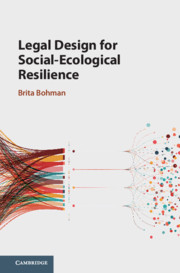Book contents
- Legal Design for Social-Ecological Resilience
- Legal Design for Social-Ecological Resilience
- Copyright page
- Contents
- Preface and Acknowledgments
- Table of Treaties and International Instruments
- Table of EU Law
- Table of Cases
- Abbreviations
- 1 Introduction
- 2 Environmental Law
- 3 Law and Governance
- 4 Defining Features for Resilience Governance
- 5 Adaptivity, Flexibility and Transformability
- 6 Multidimensional and Polycentric Structures
- 7 Stakeholders and Structures for Participation
- 8 Operationalization, Monitoring, Compliance and Trust Building
- 9 Conclusions – Effective Legal Design for Resilience Governance
- References
- Index
6 - Multidimensional and Polycentric Structures
Published online by Cambridge University Press: 10 March 2021
- Legal Design for Social-Ecological Resilience
- Legal Design for Social-Ecological Resilience
- Copyright page
- Contents
- Preface and Acknowledgments
- Table of Treaties and International Instruments
- Table of EU Law
- Table of Cases
- Abbreviations
- 1 Introduction
- 2 Environmental Law
- 3 Law and Governance
- 4 Defining Features for Resilience Governance
- 5 Adaptivity, Flexibility and Transformability
- 6 Multidimensional and Polycentric Structures
- 7 Stakeholders and Structures for Participation
- 8 Operationalization, Monitoring, Compliance and Trust Building
- 9 Conclusions – Effective Legal Design for Resilience Governance
- References
- Index
Summary
In the resilience theories, multilevel, cross-scale and polycentric governance approaches represent a governance approach that can match ecological dynamic structures and scales, as well as a structure providing for a diversity of measures. Multilevel and polycentric governance are generally displayed in how societies are governed with dynamic levels, including nested, intertwined contacts, and cooperation among a number of actors and organizations. The legal system is by nature similar to resilience governance structures when it comes to multilevel governance. Law is developed, structured, designed, adopted, and implemented at many different scales and levels in parallel and is often governed by separate authorities or administrative organizations. Law is constituted by nested systems and measures that function in parallel at different geographical and temporal scales. However, in the perspective of matching law with resilience, this feature calls for a review of, e.g., authority, coordination, review, and the implementation in overlapping, polycentric legal systems.
Keywords
- Type
- Chapter
- Information
- Legal Design for Social-Ecological Resilience , pp. 90 - 114Publisher: Cambridge University PressPrint publication year: 2021

